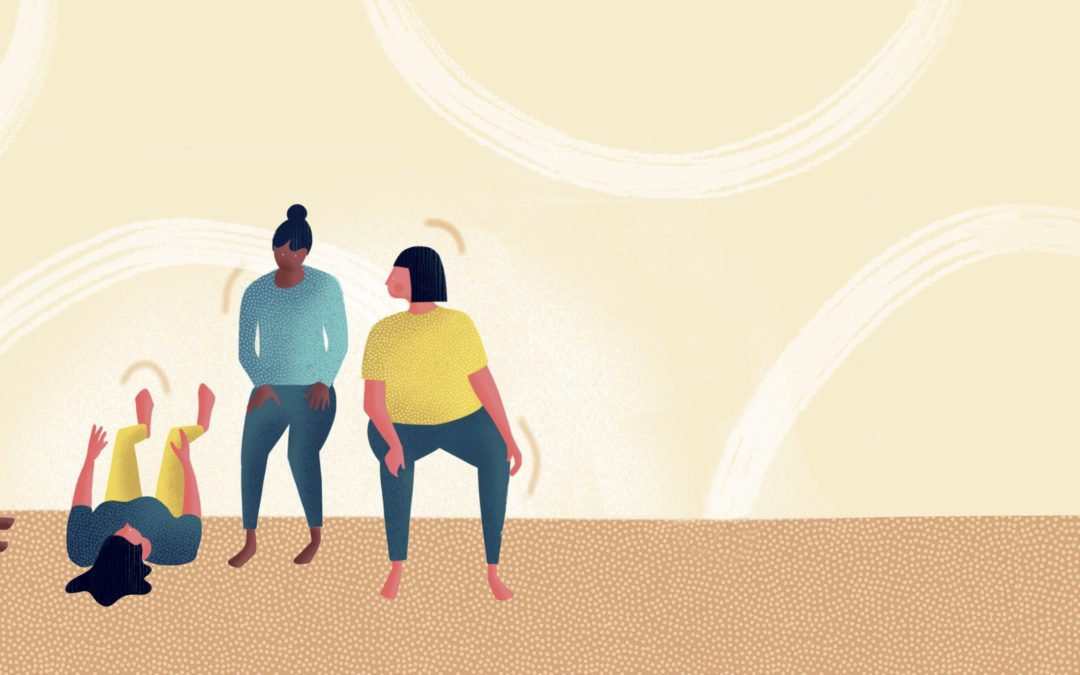I think it’s very useful to define trauma as “anything that overwhelms our ability to cope”, as well as to view trauma as a continuum.
The overwhelm that leads to trauma patterns in the body may be from a specific experience such as a car accident, sexual abuse, sudden death of a loved one or returning from a war zone. However, it could also be born from feeling overcome by work stress, your boss shouting at you, arguing with your spouse, falling off your bike or dealing with ongoing microaggressions as someone with a marginalised identity.
Both a traumatic event, and an accumulation of smaller experiences can lead to chronic tension and stress patterns that overwhelm our experience. It all travels through the same neural pathways.
For many years, I’ve been guiding people in an embodied approach to trauma healing that relies on the body’s natural capacity to release long-held trauma and tension patterns. It’s called Trauma and Tension Releasing Exercises (TRE).
TRE has been shown to over one million people now. The creator, Dr. David Berceli – a trained psychologist and expert in both trauma work and international conflict resolution – has done incredible work in developing a system which invites the body to heal itself. TRE is essentially ‘you, healing you”.
Bercelli developed TRE after his experiences in war-torn areas in Africa and the Middle East, and it is now being used all over the world in post-disaster situations. I’ve been teaching TRE and training others to teach TRE for 8 years now, and I was deeply moved recently during a training in Kyiv, Ukraine, hearing stories of how the students have been using TRE to support their clients and communities as the war has continued to make their everyday lives incredibly challenging.
Today I’d like to explore how TRE helps us to engage our bodies to transcend trauma, whether we’re working with a recent traumatic situation, are looking to heal traumas from the past, or simply want to free up long-held tension patterns.
1 Learning to Shake
TRE is essentially a process of learning how to shake. Have you ever seen a dog or cat shake something off – whether it’s excitement from a new visitor arriving, releasing a build up of emotions after a fight, or getting over some invasive poking and prodding at the vet?
They shake from the tip of their nose to the end of their tail and almost immediately recover from something physically or emotionally uncomfortable.
We humans, like all animals, also have the ability to “shake off” our tension patterns in a similar way. We shake involuntarily after intense experiences like being in an accident, giving birth, or after public speaking.
Usually we’re encouraged to stop shaking – but shaking it off is actually a valid thing to do for your nervous system. We don’t shake because we are traumatized, we shake as a response. It’s a very primitive, natural mechanism which moves through the body, unwinding and unraveling and releasing chronic tension patterns.
2 Waking up Our Experience of Our Bodies
TRE helps us to feel your body in new ways, and wake up a profound sense of peace and calm. Life is much easier when we’re not holding tight all the time. Many of us don’t realise the tension we’re holding; in our diaphragms, our back muscles, our neck muscles. When they release it creates a sense of bodily ease, but also mental, emotional and spiritual ease. Life feels easier.
Trauma can take us to a very primitive place of fight–or–flight or dissociation. It’s very hard to live fully with a brain screaming “danger!”, and generating life or death scenarios at the slightest stimulus.
The best way to reset the old parts of our brain is to slowly wake up the body. Healing trauma is not about remembering. TRE helps us to turn down intense reactions in the body.
3 TRE is You, Healing You
It’s a self-regulating process. The therapist or group are useful to help you get started, but ultimately we want you to go away and shake and learn how your body moves, and learn how you can let go of the tension patterns yourself.
Although the psychology of trauma can be complex, the physiology is relatively simple. In trauma old parts of the brain are fixed in defence cascades of ‘fight-or-flight’ or ‘freeze’. TRE® is a safe, natural process to re-boot overprotective reflexes.
Whether you’re a healthcare professional and you want to share these tools with the people you work with, or you simply want to learn how to “shake it all off”, I invite you to join one of our TRE intro days, to learn how this simple set of exercises can help reset the reflexes and habits in the central nervous system, release tension and wake up your body.
Upcoming Trainings:
Tension and Trauma Releasing Exercises (TRE®):
TRE intro days:
London: 11 Mar, 20 May, 15 Jul, 23 Sep, 18 Nov
New TRE 1 year Training
London: Starts June 2024
Biodynamic Craniosacral Therapy (BCST):
The Art of Touch 2 Year Training: London – starts Oct 2024
The Art of Touch 2 Year Training: Galway – starts Mar 2024
The Art of Touch 2 Year Training: Waterford, Ireland – starts Oct 2024
Art of Touch Craniosacral intro evening:
London: 7 Mar, 9 May, 11 Jul, 19 Sep
Galway: 1 Feb, 11 Apr


